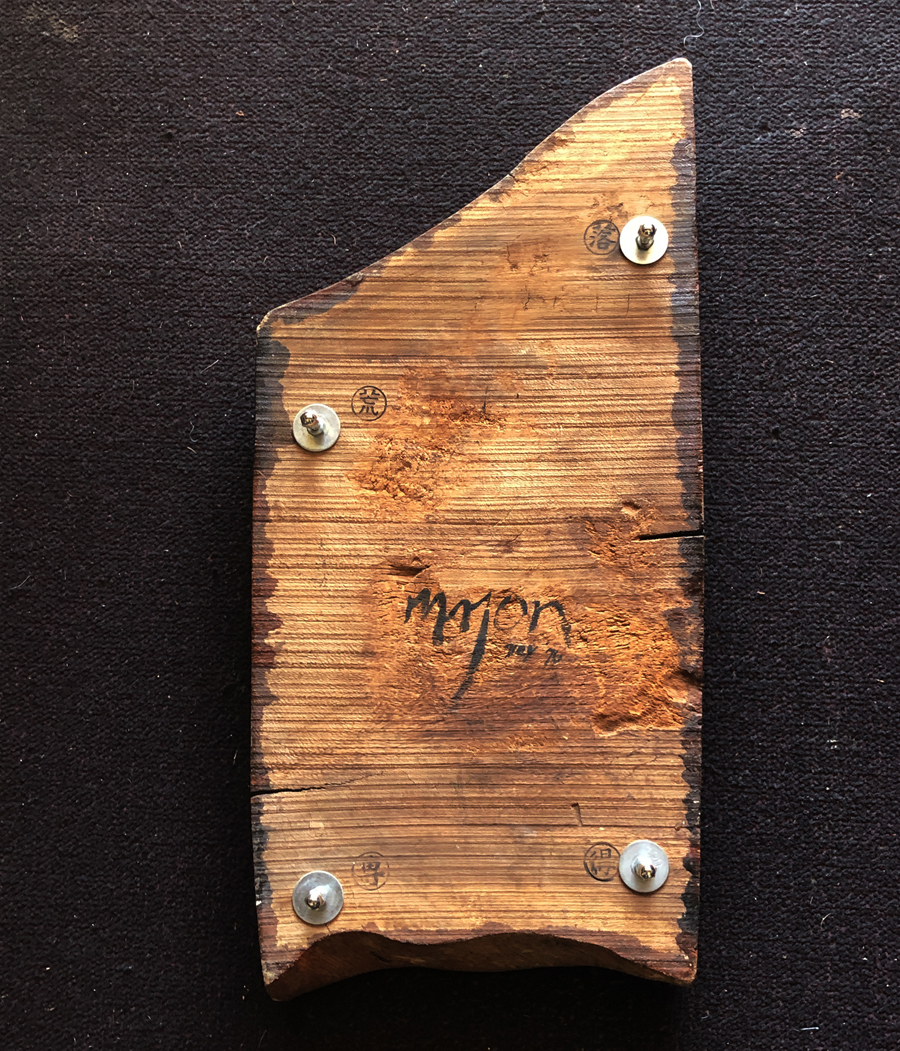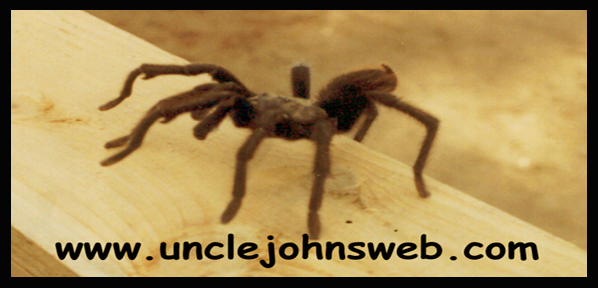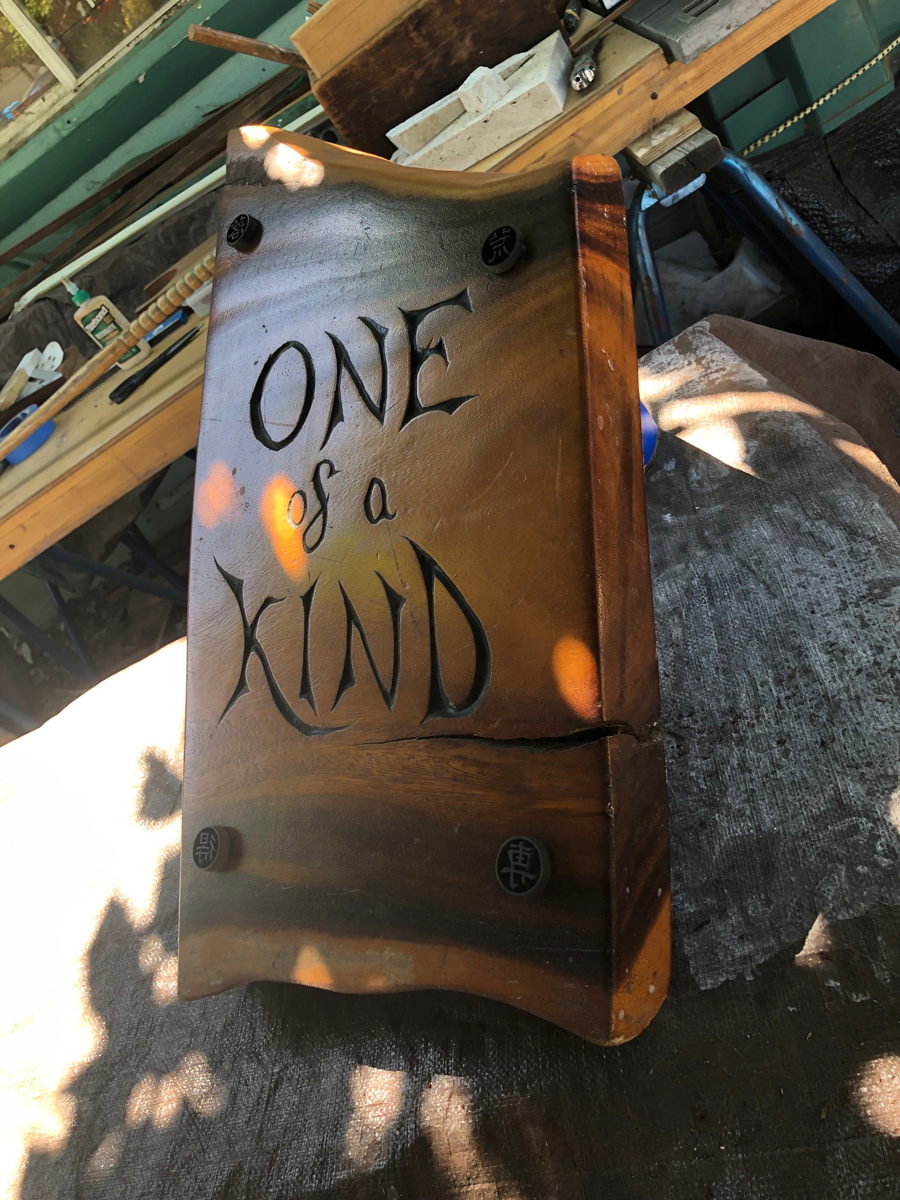
One of a Kind Sign
Here's something that I created in 1976, gave away in 1977, had returned to me 10 years later, and has resided in storage ever since. Unlike the other items in this book, I have sold this thing twice, only to have the deal fall through. The price was $200 both times, which seemed just about right. Not for sale now.

The village of Keaau on the Big Island was built as a sugar town. It sits at a crossroads where the main road from Hilo up to Volcano branches off through the Puna District to Pahoa and further to the black sands of Kalapana, on to the Chain of Craters road up to the volcano and you can loop around back down to Keaau. It's an 80-mile drive.
I separated from my wife in Hilo a year before, and went to the mainland to raise some cash. My first project was to do some restoration on an enormous Italianate Victorian in Boyle Heights on the western edge of Los Angeles' East Side near the center of the city.
The place had been originally built as a "Florence Crittenton Home for Unwed Mothers" in 1876,
but by the time I first arrived there in 1971, it was an outpost of our Bay Area communal experiment, owned by an Orange County doctor. I was there as a visiting teacher to conduct a weekend seminar on "Advanced Communication", with Patti, Dick and Carol.
Years later, in 1975 I had arrived from Hawaii with my tools, and it so happened that the doctor needed some work to be done on that place. It was no longer being used as a communal house, and during a time when it was vacant, it had been vandalized. I was put to work repairing some features on the interior, and replacing an exterior staircase that was damaged with dry rot.
There was insurance money to pay me, and it was agreed that I would just present an invoice at the end, and get paid whenever. I was saving up for another run at Hawaii, so having the money held back kept me from spending any of it. By the end of 1975, I was done with that project and headed up to San Francisco.
Up north, I stayed with other old friends in the City. This time my projects included painting the sun-baked east facing backside of the house, putting new linoleum in one of the bathrooms, and a bed platform high enough to slide big trunks under in the bedroom I was using. The project that I thought would help fund my return to Hawaii, was to make a back room on the top floor into a greenhouse. My payday was going to be half of the proceeds from the first crop.
In June, I had figured I needed to get back to Hawaii in time to have something going when it was time for Johnny to start Kindergarten. I had finally gotten a few thousand bucks from the Boyle Heights project that would help me get started.
Back in Hawaii, I found that my friends Roger and Bonnie were involved in a project in Keaau. A fellow named Robyn Buntin had leased some old buildings in the middle of town and had enlisted Roger into turned into a bunch of small shops. One was to be Robyn's Art Gallery, another Roger's furniture making shop, and another was a small deli facing the street. He called it "The Sugar Mill Mall". Across the street was "Akiyama Store", sort of a neighborhood store with snacks, a small amount of groceries, crack seeds, rolled sushi, beer, wine, booze and cigarettes. Mrs. Akiyama was the good-natured matriarch and landlord of this part of town. The Sugar Mill Mall was leased from her, and the buildings on her side of the street. On her south side were two big buildings that had become "Gaughen's Emporium" a second hand store, and Colin McIver's sewing machine shop. On her north side was a small building that had been a lawnmower repair shop but was currently empty. That's the one that I rented from Mrs. Akiyama.
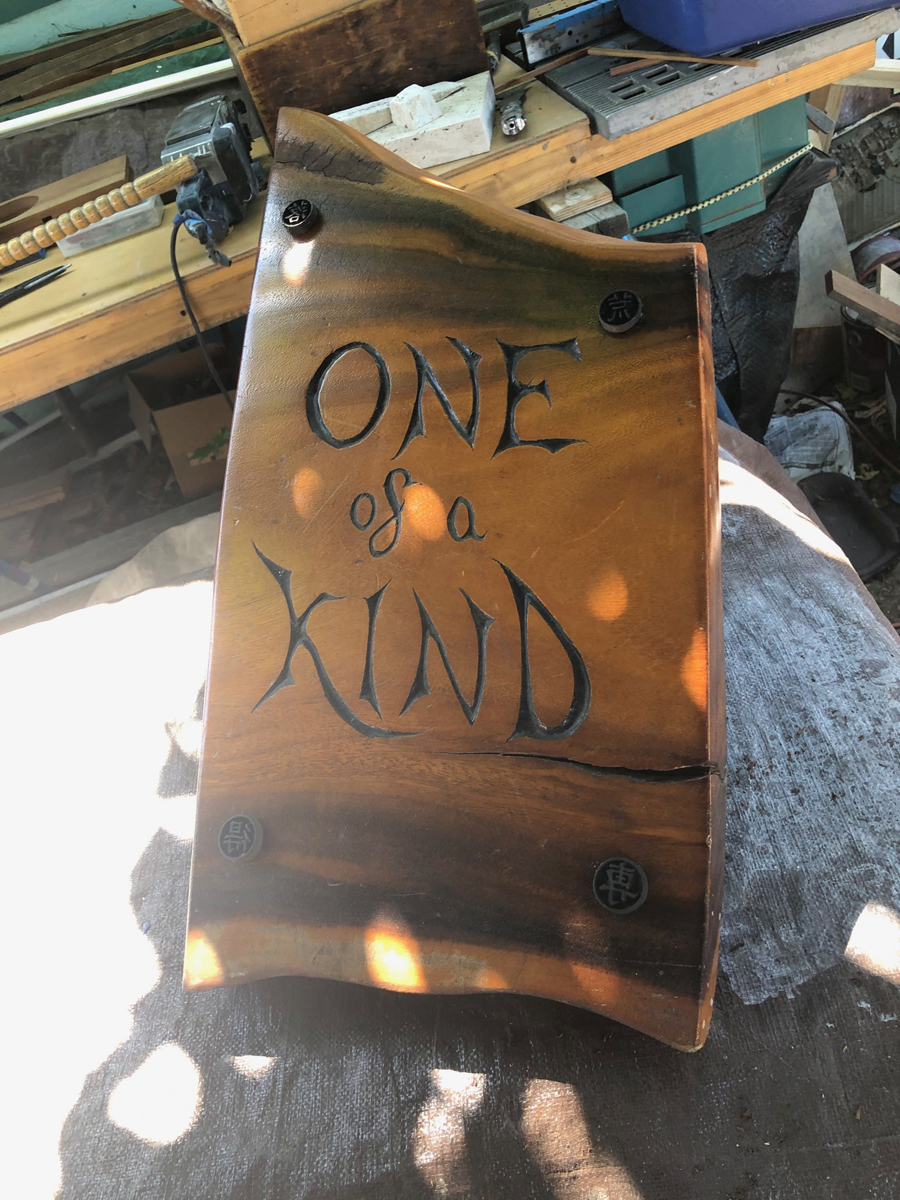
I covered the front with 5 inch wide thin redwood bender board which I sanded smooth outside. I trimmed the door and window with fir 1 X 5 put together at the corners like puzzle pieces. A sunburst of that same redwood radiated in the gable, trimmed with the same puzzle piece fir. Then the whole works was sealed with a glossy clear coat.
The narrow wood floor between the facade and the sidewalk I covered with roughly 10" irregular leftovers of 1/2" plywood cut, shaped and rounded over to fit together like a jigsaw puzzle. I found a discarded carpet at the dump that nicely filled the whole space. The counter that ran 2/3 of the way across the room had two old planks for its top, which I worked with chisel down to the bare wood and sanded it smooth until it had a scrub-planed appearance.
I started by stocking the Rolling Stone, rolling papers and incense; and putting together a monthly handout calendar and tide chart I called "Puna Moon and Tides", advertising local businesses, my own store, and emergency phone numbers.
I came across two odd pieces of wood. One was a wedge shaped chunk of mango wood that was already the shape of a big apple slice. I carved a seed in the appropriate position and painted the side that had been the smooth exterior of the tree a dark glossy red and found a way to make tiny white speckles like a red delicious apple.
The other piece was a small slab of monkeypod wood, from a certain kind of acacia tree, similar to koa wood but with a more chocolate color and without that distinctive aroma when you cut it like koa. I thought it would make a classy sign for the front of the store. I found four Japanese branding irons with 9-inch long tangs on them that I could use to affix the sign to the wall, Appropriately, the brands were "Water", "Forest", "Wood" and "Incense".
I focused on making the store a thing of beauty, thinking when my share of the crop came in, I would stock it with inventory. But the crop was a flop as the chicken poop was too hot; and the plants burned and were pulled out. The crop needed to be planted all over again. I had a beautiful storefront, but with not enough for sale to cover the rent, I gave up on the venture. I sent Johnny off to stay with his grandparents in Northern California, and I went in search of another bankroll. This time I signed on to a very risky enterprise ended in a disaster with little payday. Except for his month long visits in the summers while I was living on the mainland, I was not able to set up a situation where I could be living again with Johnny until 1979.
I sold off what belongings I had collected. I actually sold the big apple slice to Robyn Buntin. By that time I had realized that the seed was too flat to call an apple seed, so I named it "Apple Slice with Watermelon Seed". That was quite an acknowledgement coming from an art dealer. I wonder where that piece went. I'm pretty sure he took it with him when he moved to Oahu and set up an art gallery in Honolulu. I bet its owner doesn't know its title or creator.
I had a two-shot .22 derringer that had been a gift on my 28th birthday. I sold it to Colin McIver. Where I was going, a handgun would only be a problem. As it turned out, it would have been a big problem. I did save my collection of carpenter's tools. I would need those for the rest of my days. Don't have a tool you don't want to use.
The sign, I abandoned in the back room of the shop when I left. A few years later, Patti looked in on the new tenants and found it there. They gave it to her, but the original branding irons were gone. I more recently replaced the irons with others. The new ones are the characters that It seem to be a scale of quality: Special, Average, Crude, Fallen. I reversed the photos so that they equal the branded images.
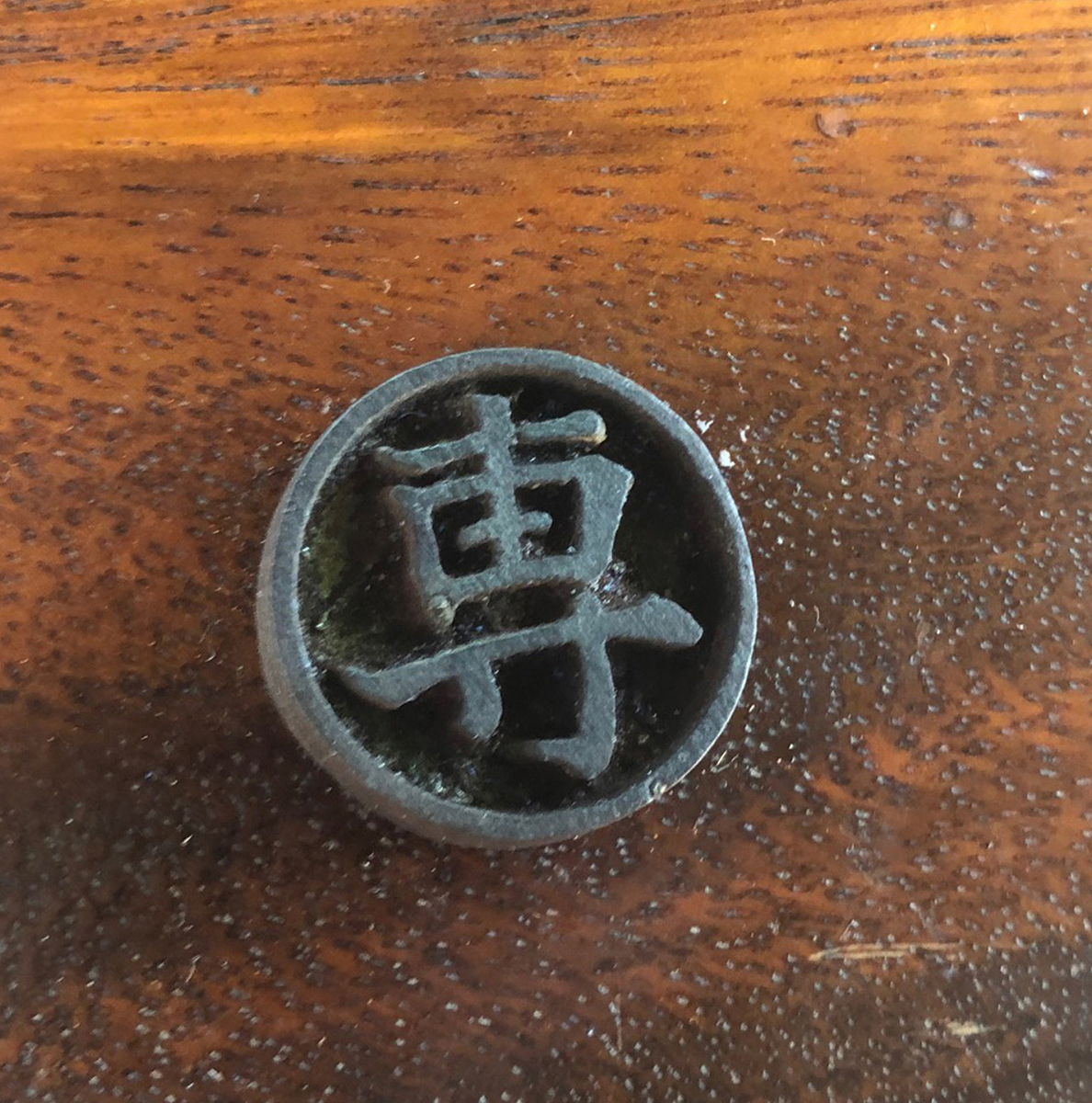
= Special, specific, assigned
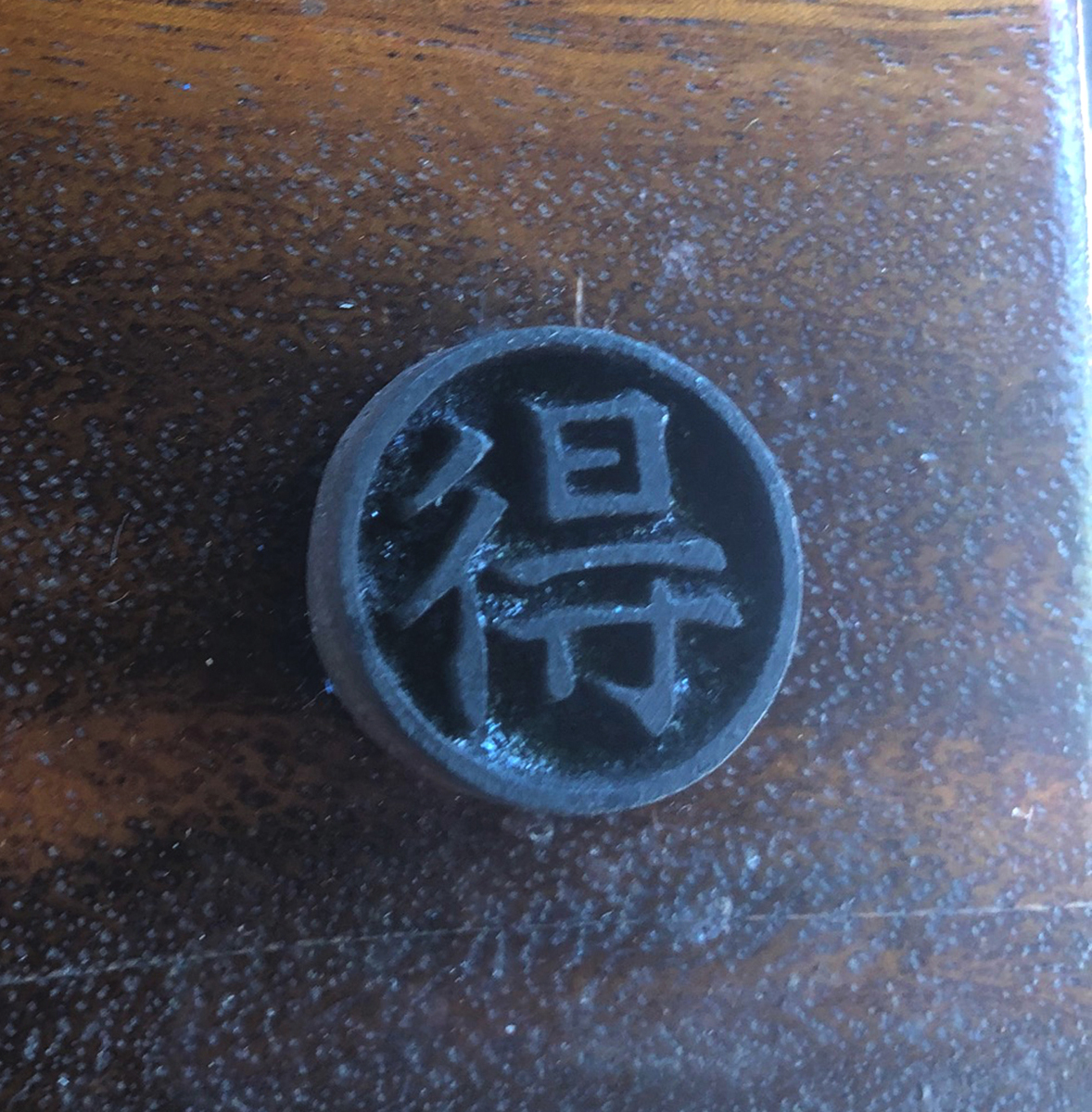
= Multi-purpose, acceptable, average
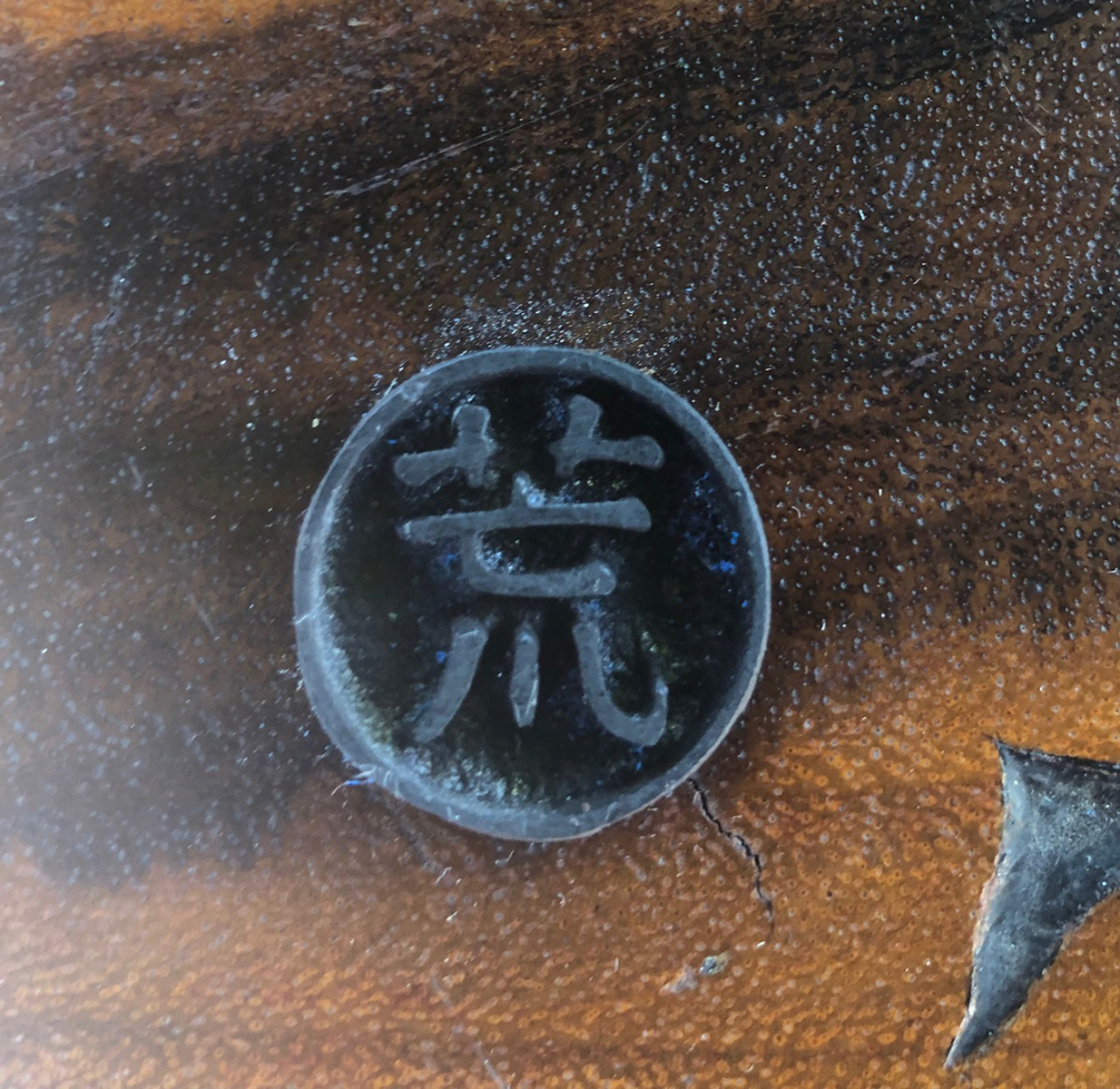
= rough, crude
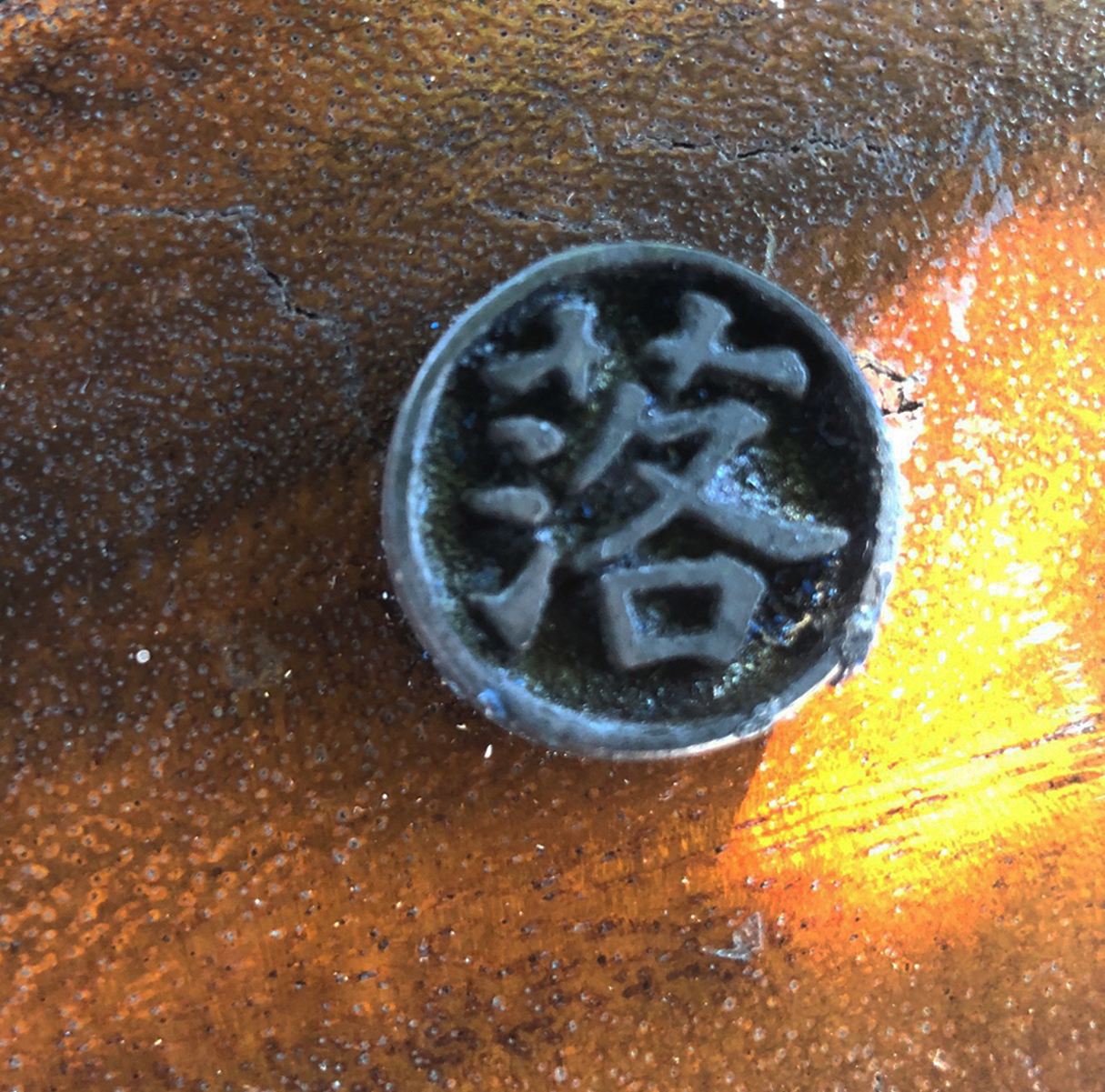
= cut-off, not up to standard, fallen.
I was holding off writing this story until the sign was sold. I hoped the buyer wouldn't read this and have it erase whatever charm it had for her or him. Here's the deal; I really liked that sign; the grace of the the carved calligraphy and how cool the branding iron "nails" looked when it was attached to the front of the store. I was driving to Hilo one day and as I passed a billboard that I had driven by innumerable times, when I realized what it said: "One of a Kind" with a picture of a rugged looking cowboy smoking a cigarette. It was an ad slogan for Camel Filters cigarettes, which I realized to my disgust, was the brand I was smoking at the time! After that, everytime I picked up a magazine or newspaper, I saw the same thing.
My father died of lung cancer from his lifelong smoking habit at the age of 78. My older sister died of lung cancer after smoking in her 20's and 30's. She quit when she was 35, but it had created lesions that became tumors that she died of at age 77. My grandmother on my mother's side died of it though she had never smoked herself. She had been damaged by years of the ubiquitous second hand smoke of her husband, her brothers, her children and everyone she shared a household with. Cigarettes are killers.
I don't like that sign any more, it reminds me of that painful time when I faced defeat...and how a cigarette company's ad slogan had seeped into my brain, while its poisonous smoke had filled my lungs. "Camel Filters...One of a Kind".
I took the sign down and replaced with one that said "Majon Store", a nickname I used for a short time, pronounced like "Mad John". Yup.
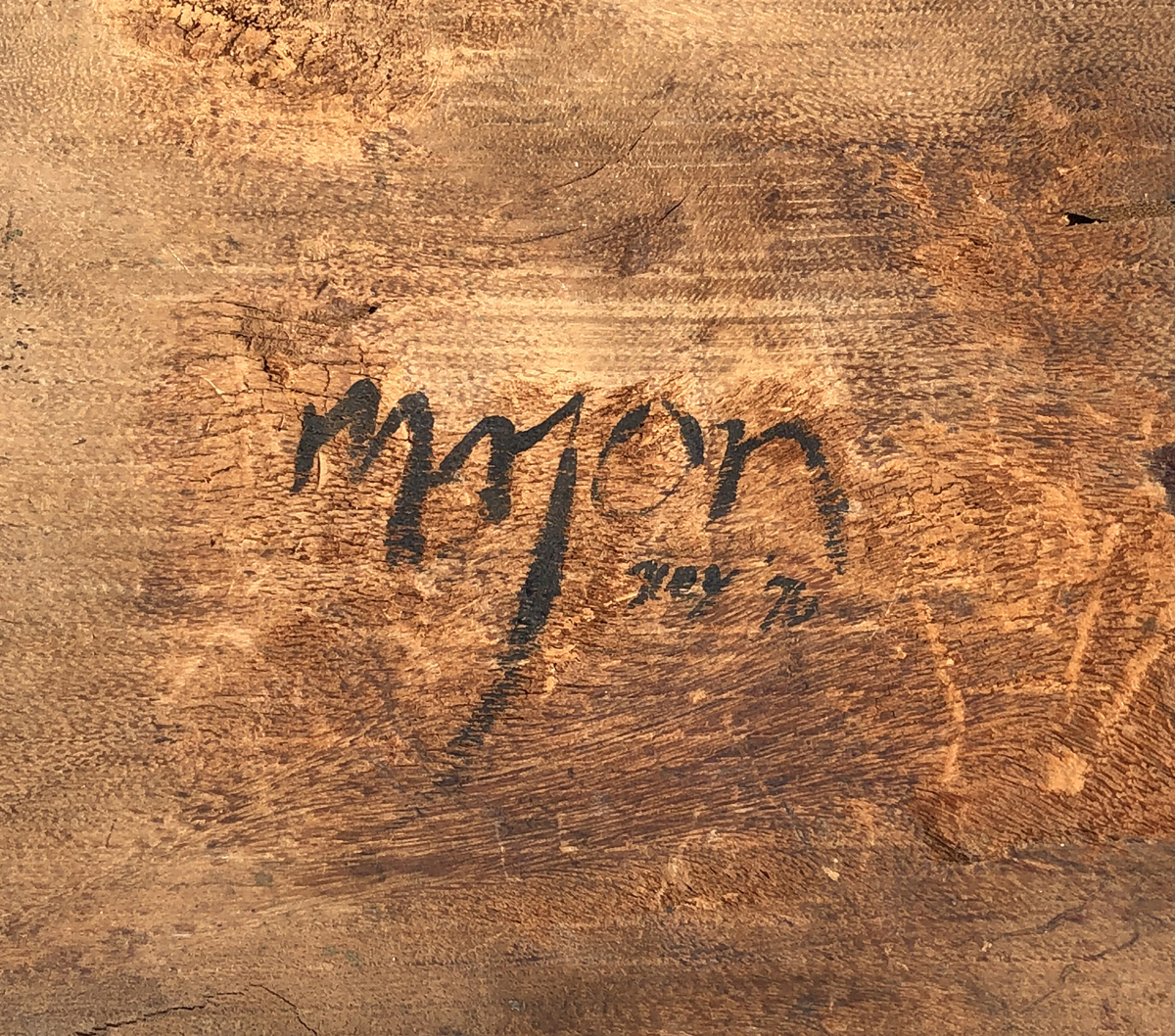
Here's something that I created in 1976, gave away in 1977, had returned to me 10 years later, and has resided in storage ever since. Unlike the other items in this book, I have sold this thing twice, only to have the deal fall through. The price was $200 both times, which seemed just about right. Not for sale now.

I separated from my wife in Hilo a year before, and went to the mainland to raise some cash. My first project was to do some restoration on an enormous Italianate Victorian in Boyle Heights on the western edge of Los Angeles' East Side near the center of the city.
The place had been originally built as a "Florence Crittenton Home for Unwed Mothers" in 1876, but by the time I first arrived there in 1971, it was an outpost of our Bay Area communal experiment, owned by an Orange County doctor. I was there as a visiting teacher to conduct a weekend seminar on "Advanced Communication", with Patti, Dick and Carol.
Years later, in 1975 I had arrived from Hawaii with my tools, and it so happened that the doctor needed some work to be done on that place. It was no longer being used as a communal house, and during a time when it was vacant, it had been vandalized. I was put to work repairing some features on the interior, and replacing an exterior staircase that was damaged with dry rot.
There was insurance money to pay me, and it was agreed that I would just present an invoice at the end, and get paid whenever. I was saving up for another run at Hawaii, so having the money held back kept me from spending any of it. By the end of 1975, I was done with that project and headed up to San Francisco.
Up north, I stayed with other old friends in the City. This time my projects included painting the sun-baked east facing backside of the house, putting new linoleum in one of the bathrooms, and a bed platform high enough to slide big trunks under in the bedroom I was using. The project that I thought would help fund my return to Hawaii, was to make a back room on the top floor into a greenhouse. My payday was going to be half of the proceeds from the first crop.
In June, I had figured I needed to get back to Hawaii in time to have something going when it was time for Johnny to start Kindergarten. I had finally gotten a few thousand bucks from the Boyle Heights project that would help me get started.
Back in Hawaii, I found that my friends Roger and Bonnie were involved in a project in Keaau. A fellow named Robyn Buntin had leased some old buildings in the middle of town and had enlisted Roger into turned into a bunch of small shops. One was to be Robyn's Art Gallery, another Roger's furniture making shop, and another was a small deli facing the street. He called it "The Sugar Mill Mall". Across the street was "Akiyama Store", sort of a neighborhood store with snacks, a small amount of groceries, crack seeds, rolled sushi, beer, wine, booze and cigarettes. Mrs. Akiyama was the good-natured matriarch and landlord of this part of town. The Sugar Mill Mall was leased from her, and the buildings on her side of the street. On her south side were two big buildings that had become "Gaughen's Emporium" a second hand store, and Colin McIver's sewing machine shop. On her north side was a small building that had been a lawnmower repair shop but was currently empty. That's the one that I rented from Mrs. Akiyama.

The narrow wood floor between the facade and the sidewalk I covered with roughly 10" irregular leftovers of 1/2" plywood cut, shaped and rounded over to fit together like a jigsaw puzzle. I found a discarded carpet at the dump that nicely filled the whole space. The counter that ran 2/3 of the way across the room had two old planks for its top, which I worked with chisel down to the bare wood and sanded it smooth until it had a scrub-planed appearance.
I started by stocking the Rolling Stone, rolling papers and incense; and putting together a monthly handout calendar and tide chart I called "Puna Moon and Tides", advertising local businesses, my own store, and emergency phone numbers.
I came across two odd pieces of wood. One was a wedge shaped chunk of mango wood that was already the shape of a big apple slice. I carved a seed in the appropriate position and painted the side that had been the smooth exterior of the tree a dark glossy red and found a way to make tiny white speckles like a red delicious apple.
The other piece was a small slab of monkeypod wood, from a certain kind of acacia tree, similar to koa wood but with a more chocolate color and without that distinctive aroma when you cut it like koa. I thought it would make a classy sign for the front of the store. I found four Japanese branding irons with 9-inch long tangs on them that I could use to affix the sign to the wall, Appropriately, the brands were "Water", "Forest", "Wood" and "Incense".
I focused on making the store a thing of beauty, thinking when my share of the crop came in, I would stock it with inventory. But the crop was a flop as the chicken poop was too hot; and the plants burned and were pulled out. The crop needed to be planted all over again. I had a beautiful storefront, but with not enough for sale to cover the rent, I gave up on the venture. I sent Johnny off to stay with his grandparents in Northern California, and I went in search of another bankroll. This time I signed on to a very risky enterprise ended in a disaster with little payday. Except for his month long visits in the summers while I was living on the mainland, I was not able to set up a situation where I could be living again with Johnny until 1979.
I sold off what belongings I had collected. I actually sold the big apple slice to Robyn Buntin. By that time I had realized that the seed was too flat to call an apple seed, so I named it "Apple Slice with Watermelon Seed". That was quite an acknowledgement coming from an art dealer. I wonder where that piece went. I'm pretty sure he took it with him when he moved to Oahu and set up an art gallery in Honolulu. I bet its owner doesn't know its title or creator.
I had a two-shot .22 derringer that had been a gift on my 28th birthday. I sold it to Colin McIver. Where I was going, a handgun would only be a problem. As it turned out, it would have been a big problem. I did save my collection of carpenter's tools. I would need those for the rest of my days. Don't have a tool you don't want to use.
The sign, I abandoned in the back room of the shop when I left. A few years later, Patti looked in on the new tenants and found it there. They gave it to her, but the original branding irons were gone. I more recently replaced the irons with others. The new ones are the characters that It seem to be a scale of quality: Special, Average, Crude, Fallen. I reversed the photos so that they equal the branded images.

= Special, specific, assigned

= Multi-purpose, acceptable, average

= rough, crude

= cut-off, not up to standard, fallen.
My father died of lung cancer from his lifelong smoking habit at the age of 78. My older sister died of lung cancer after smoking in her 20's and 30's. She quit when she was 35, but it had created lesions that became tumors that she died of at age 77. My grandmother on my mother's side died of it though she had never smoked herself. She had been damaged by years of the ubiquitous second hand smoke of her husband, her brothers, her children and everyone she shared a household with. Cigarettes are killers.
I don't like that sign any more, it reminds me of that painful time when I faced defeat...and how a cigarette company's ad slogan had seeped into my brain, while its poisonous smoke had filled my lungs. "Camel Filters...One of a Kind".
I took the sign down and replaced with one that said "Majon Store", a nickname I used for a short time, pronounced like "Mad John". Yup.
